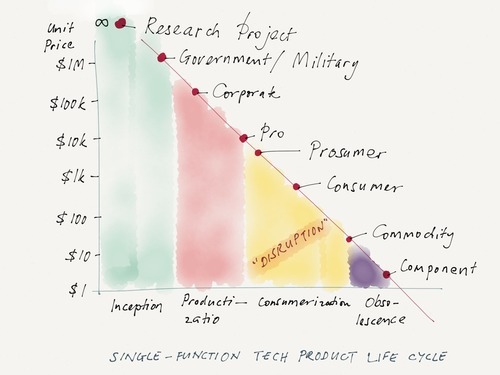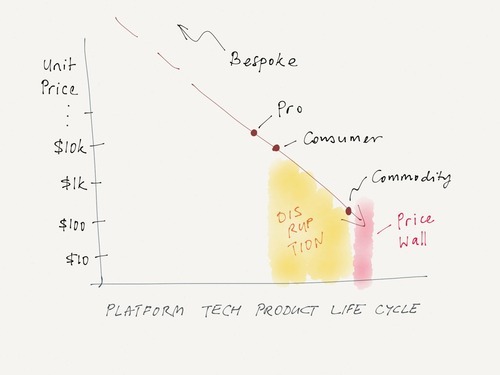A Tale of Two Obsoletives
Ben Thompson’s excellent post on “obsoletive” products got me thinking about the phenomena of low-end disruption and obsolescence as they apply to technology products.
Both circumstances are clearly at play. But it’s my observation that each type of disruption tend to happen mostly to different classes of products.
Tools Get Low-End Disrupted
Products that tend to get disrupted by low-priced alternatives fall into a category I call tools. These are products that generally solve a single problem. Tools can be cheap and simple, such as a flashlight, or highly complex, such as GPS receivers. No matter their complexity, they are meant to solve one problem, be it “light up a dark area”, or “locate my position”, or even “send a signal over the air”.
The life-cycle of tools tend to follow this path:

A tool may not start off at the high end, of course. But for those that do (GPS, radio receivers, television, copiers, fax machines), they typically begin their commercial life as expensive corporate devices.
These tools are highly susceptible to low-end disruption. As long as the problems they solve remains commercially interesting, any means of lowering the price of the tool will yield benefits to the innovator, at the expense of incumbents who are now competing on price. These price cuts can come from new technologies or materials, new manufacturing processes, or a more efficient product design.
Often times, the downward path of tool pricing will be reset by new technology that makes the old one obsolete. Reel-to-reel tape is replaced by LPs, which are replaced by CDs, for instance. In each case, the price point is “reset” back up the slope, only to resume its downward roll once again.
As long as commercial interest in solving the problem remains strong, the downward price trajectory of a tool will continue until the tool becomes a commodity. At this point, any instance of a tool is basically as good as any other, and competition becomes primarily a race to zero dollars. Many household appliances have reached this point, and so have many single-purpose electronic devices you can buy at Home Depot or Walmart.
The distinguishing characteristic of tool pricing, however, is its ability to go even lower than commodity pricing, by turning into a component. When a camera product becomes a camera chip, then the entire product category becomes ripe for obsolescence.
Platforms Get Obsoleted
Tools that have become components eventually become parts for general-purpose platforms. The defining characteristic of platform products is that they are not intended to solve any particular problem, but to solve any problem within reach of its software and hardware. Platform products include general-purpose computers, smartphones, and (I suspect) automobiles.
Something interesting happens to platforms: they do not get low-end disrupted the same way that tools are:

Because a platform is a general-purpose device, for a platform to satisfy its users, there has to be a certain measure of capability that it must possess (speed, capacity, portability, battery power). This puts a floor on how low the price can be while still maintaining reasonable performance. Even “commoditized” platforms hit this plateau eventually.
Another phenomenon that defines platforms is that they tend to use completely commoditized components; their distinctiveness are in the presentation of their functions (UI, form factor, esthetics). That means that when any particular component’s price takes a drop, all competing platforms that use that component can take advantage of its benefit. Since all competitors enjoy the same savings, low-end disruption is not in play.
Platforms are, obviously, still susceptible to obsolescence. But the mechanism of obsolescence is very different to that of tools. Platforms are obsoleted when a new form factor is introduced that brings inherent benefit to the end user. A successful new form factor usually requires a new user interface and input/output mechanism to go along with it. A preassembled all-in-one computer with a keyboard can obsolete a kit computer. A touch screen on a pocketable computer with a touch-oriented UI can obsolete a cursor key-based PDA.
Such platform obsolescence obviously occur at a relatively slow pace, maybe twice a decade. However, the impact of platform obsolescence is devastating on tools. Each time a revolutionary platform arrives, it tends to obsolete a whole range of tools that have now become mere components in a single platform. Add to that the fact that platform performance tends to grow rapidly—allowing platforms to subsume more and more functions currently served by tools—and the effect of platforms on tools becomes even more substantial.
One Is Not Like The Other
Treating platform obsolescence the same way as tool obsolescence is a mistake. Platforms are not susceptible to low-end disruption in the way that tools are. Platforms reach a low-end limit to pricing, because it has to maintain performance, while tools are more likely to continue its descent into commodity pricing, and finally, to becoming a mere component on a platform.
Disclaimer
It should be obvious by now that I’m not an analyst or economist. The phenomena I describe are based on my years of observation of and work in the technology industry. I’m sure I have a lot to learn on the subject, so please let me know what you think by tweeting me at @drahardja.